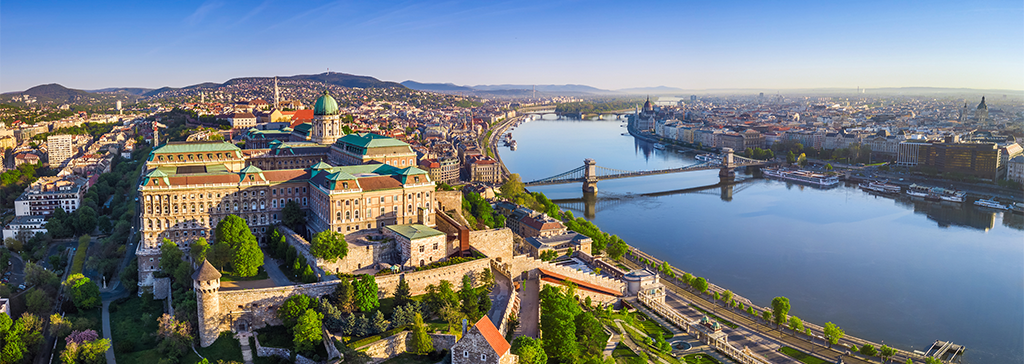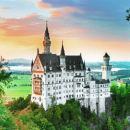
Budapest
See the best of Budapest
Up-and-coming Budapest brings together east and west as a city that bridges both Buda and Pest, and western and eastern Europe. Despite its turbulent history, the city never fails to remain vibrant and diverse. Use our guide to see the best of Budapest, from grandiose architecture and thermal baths to memories of the past and bohemian bars.
Top attractions

- Central Market Hall
-
![budapest-hungary-central-market]()
The Central Market Hall in Pest, on the east side of the Danube River, is the perfect place to start your visit. Budapest's oldest and largest market contains stalls spread across three levels, so you should be able to find the perfect dish to satiate your taste buds at any time of the day. Try traditional lángos, a deep-fried dough topped with sour cream and grated cheese.
- Gellért Hill
-
![budapest-hungary-gellert-hill-liberty-statue-smaller]()
Cross the Liberty Bridge to reach the Buda side (west) of the Danube. Here you can find the steep but brief footpath to the top of Gellért Hill. Take a well-deserved break at the summit as you take in sweeping views of the city, best at sunrise and sunset.
Besides incredible views, you will also find the dramatic Liberty Statue and the Citadella, an imposing fortress built in 1848-9, which never saw a battle.
- Castle Hill
-
![hungary-budapest-friends-sitting-in-fisherman-bastion]()
Go north to District I, the Castle District, where you can find some of Budapest's most famous buildings on a hill above the Danube. Take a funicular railway up to Buda Castle, where you can visit the Hungarian National Gallery or eat a goulash lunch with a view.
The Instagrammable Fisherman's Bastion is not far from the castle. It looks like a medieval fairytale palace, but it is actually one of Europe's most extravagant viewpoints, built-in 1902 to provide a glorious view across the Danube to Pest.
- Danube Promenade (Dunakorzó)
-
![budapest-hungary-shoes-on-the-danube-small]()
Use the Chain Bridge to cross back to the Pest side. When opened in 1849, the bridge formed the first permanent link between Buda and Pest, so it is an icon not just by design, but for its historic role in physically uniting Budapest.
Walking northwards along the Danube Promenade, you can see the Shoes on the Danube Bank. The memorial is a poignant reminder of how Hungary's Jewish community suffered during the Holocaust, when men, women and children were ordered to remove their footwear before being shot into the river. Walk further to admire the palatial Hungarian Parliament building, the world's third largest. Viewed from the Buda banks, the building has the appearance of floating on the Danube!
- Basilica of St Stephen
-
![budapest-hungary-gelarto-rosa-theofinger]()
Hungary's most sacred Catholic church, the Basilica of St Stephen, is in the city center. Climb the dome for a great view, and make sure not to miss out on the chance to see a mummified right hand - that of King St Stephen!
Pop into Gelarto Rosa, across from the basilica, for a delicious gelato with a difference - your scoops will be transformed into layers of a colorful, sweet-tasting rose!
- Andrássy Avenue
-
![budapest-hungary-house-of-terror]()
Built-in 1872 to connect Budapest's city center to Városliget (City Park), Andrássy Avenue is both a UNESCO site and beloved by Budapest locals.
You can visit the formidable House of Terror museum half-way up the avenue. Its "Double Occupation" permanent exhibition portrays Hungary's 20th-century experience under the Nazis and then the Soviets. It is harrowing but important to gain an understanding of what Hungarians have experienced within living memory.
Your trip along the avenue will culminate at Heroes' Square, a monument dedicated to those fighting for Hungary's freedom. Here you can also find the Kunsthalle and Museum of Fine Arts.
- Széchenyi Baths
-
![Budapest-thermal-baths]()
After Budapest's hilly sightseeing, you may want to join the locals and bathe in the city's healing, hot-spring waters. The most famous place to try this is the huge Széchenyi Baths spa complex, where you can swim and bubble within the terrace of a yellow palace. The complex is located just beyond Heroes' Square and City Park.
If a secluded spa experience is more your thing, then you can steam at some of Budapest's other thermal baths. Swim amongst the columns at art-nouveau Gellért Baths or go back in time to the 16th century, Turkish-style Rudas Baths.
- Ruin bars
-
![budapest-hungary-szimpla-kert-ruin-bar]()
Partying in the ruin bars of District VII is an essential night-time experience in Budapest. Szimpla Kert, established in 2002, was the original. Since then, entrepreneurs have repurposed decaying factories and tenement houses into quirky venues with bars, dancefloors and rooftop restaurants.
Ruin bars turn a night out into an adventure as you explore their many rooms and levels. Instant/Fogas is a particularly maze-like nightlife mansion created by combining two ruin bars. It's open all night and even has its own snack bar, so you never have to leave! You do not need to worry if you finish exploring these famous ruin bars because more are always popping up throughout the city.
Local tips




Escape to Margaret Island
After seeing the sights, escape to Margaret Island on the River Danube to unwind as the locals do at Budapest's main public park. It offers much green space and activities to try, including running tracks, outdoor pools and peaceful cultivated gardens. You might even stumble across the ruins of a convent or a musical fountain.

Cruise the blue Danube
At night, the lights of the Hungarian Parliament and the Chain Bridge reflect in the waters of the Danube, creating a truly magical sight. Taking a Danube River cruise is the best way to experience it. You can even join a dinner cruise to make an evening of it. For something more fast-paced, it is also possible to party on the Danube at A38, a Ukrainian cargo ship transformed into a cultural hub.

Get festive
Winter temperatures can drop as low as 15°F (-10°C), but besides the thermal baths, there are plenty of ways to stay warm and merry. You can go ice skating in front of a castle at Europe's largest rink, in City Park. Then warm up with a chimney cake. Make sure to catch a glimpse of Budapest's trams draped in Christmas lights!
Getting to Budapest
As a central European country, Budapest is well-connected, with direct links to many other European cities. International trains arrive at Keleti (Eastern), Nyugati (Western), or Déli (Southern) railway stations. Domestic InterCity trains also link Budapest to the main towns in the rest of Hungary.
You can find all trains to and from Budapest in the Eurail timetable.
Don't miss your train! It's easy to get confused by the names of the train stations in Budapest. Head to the station on the city's Buda side to depart Kelenfoeld or Pest to leave from Keleti station.
From Vienna to Budapest

From Prague to Budapest

From Bratislava to Budapest

Flights and public transport

Flights to Budapest land at Ferenc Liszt International Airport, southeast of the city. Shuttle bus 100E will drop you into the city center in just over 30 minutes. Or take metro line M3 on weekdays.

Walking is the best way to get around Budapest since most attractions are within walking distance. However, to travel away from the centre, or to rest your feet, take a bus, tram or metro.
Change of currency
You cannot change the currency once you have a Pass in your cart. Remove the Pass, and then change the currency on the website header.













